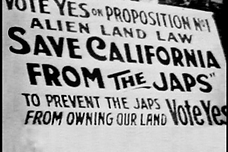About Lesson
Activity 4.2: How did the Korean Independence Movement shape and become shaped by Formation of the Korean American Identity in the United States?
 Students examine original documents and news reports from the time period to identify how the Korean Independence Movement shaped and was shaped by the formation of the Korean American identify in the United States.
Students examine original documents and news reports from the time period to identify how the Korean Independence Movement shaped and was shaped by the formation of the Korean American identify in the United States.
Protest poster encouraging a vote of YES on Alien Land Law, Proposition 1, circa 1913. (Source: Courtesy of Pioneering Punjabis Collection, University of California Davis)
Activity Questions
- In the study of migration, push factors are those that encourage a population to leave its home, and pull factors are those that draw a population to another area or place. What push and pull factors shaped Korean immigration to the U.S. in the early 1900s?
- How did California Alien Land Laws affect Korean immigrants?
- How did early Korean Americans see Japan’s occupation of Korea?
- How did the March 1 Movement shape attitudes towards Korea and Korean Americans in the United States?
- Who organized the First Korean Congress and what was its purpose?
- How did the Korean Independence Movement impact Korean Women’s groups and contribute to the Korean American women identity?
- How did the Korean Independence Movement shape and become shaped by formation of the Korean American identity in the United States?
Instructional Strategies
- Use the Lesson 4: The Korean Independence Movement (Activity 4.2) presentation to support this lesson.
Home Groups and Activity Introduction
- Divide students into 6-member groups. These Home Groups should be diverse in terms of gender, ethnicity, race, and ability. Identify one student as the leader.
- Inform students that today they will be exploring the following question: How did the Korean Independence Movement shape and become shaped by the formation of the Korean American identity in the United States? Let students know that they will be “jigsawing” out of their group to examine primary sources related to a specific topic related to this question, and that they will be returning to their Home Group to summarize what they have learned.
- NOTE: Point out to students that these events were not the only ones that shaped the Korean American identify and the Korean Independence Movement. These events were selected because they are important and allow us to view original documents and news reports from the 1919s.
- Assign students in each group to one of the following categories.
- Topic Group 1: Push and Pull Factors of Korean Immigration
- Topic Group 2: California Alien Land Laws of 1913 and 1920
- Topic Group 3: Hemet California Incident
- Topic Group 4: First Korean Congress in the U.S.
- Topic Group 5: Perspectives from Korea
- Topic Group 6: Women, Christians, and Other Contributors
Topic Group Activity
- Have students “jigsaw” out to their Topic groups and distribute group materials.
- Have students review the sources provided and answer the questions. Be sure students understand that they will be the “sole expert” on this topic when they return to their Home Group and, therefore, should take good notes on the questions.
Back to Home Groups for Star Summary
- Return students to their Home Groups and have them complete Home Group Assignment. If you plan on an informal or formal writing activity to end this lesson, each member should complete their own assignment.
Closing Activity
- Have leaders of each Home Group share their response to one or more of the table cells.
Resources See also the Lesson 4 Teachers Guide and Lesson 4 Presentation, found under Activity 4.1.
- Handout: Group 1 Assignment: Push and Pull Factors of Korean Immigration (WORD/PDF)
- Handout: Group 2 Assignment: California Alien Land Laws of 1913 and 1920 (WORD/PDF)
- Handout: Group 3 Assignment: Hemet, California Incident (WORD/PDF)
- Handout: Group 4 Assignment: First Korean Congress in the U.S. (WORD/PDF)
- Handout: Group 5 Assignment: Perspectives from Korea (WORD/PDF)
- Handout: Group 6 Assignment: Women, Christians, and Other Contributors (WORD/PDF)
Handout: Activity 4.2 Home Group Assignment (WORD/PDF)
Activity 4.2 Home Group Assignment (PDF)
List of Group Resources (PDF)
Home Group 1 (PDF)
Home Group 2 (PDF)
Home Group 3 (PDF)
Home Group 4 (PDF)
Home Group 5 (PDF)
Home Group 6 (PDF)

